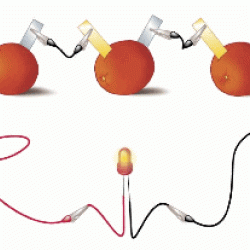Source Institutions
Source Institutions
Add to list Go to activity
Activity link broken? See if it's at the internet archive

In this activity, learners create a battery from fruit. This activity helps learners explore electricity, electrochemistry, and series circuits as well as the process of scientific inquiry. Learners will use a voltmeter to measure voltage and a multimeter to measure how much work their fruit battery can do. They will record the measurements on a data table and compare voltage amongst different types of fruits. Learners will also link together multiple fruit batteries to create a series circuit. This lesson guide includes background information, key vocabulary terms, blackline masters, and extension ideas.
- 1 to 2 hours
- 1 to 2 hours
- Over $20 per group of students
- Ages 8 - 14
- Activity, Experiment/Lab Activity, Lesson/Lesson Plan
- English
Quick Guide
Materials List (per group of students)
- 4 apples, 3 bananas, 3 oranges
- 10 small bags (plastic sandwich bags or lunch bags) to put the electrodes in
- 10 strips each of copper, aluminum and zinc
- 10 digital multimeters set to measure up to 2 V (with alligator clips)
- 6 red LEDs (Light Emitting Diodes) rated at 3 V
- Some leads with alligator clips
- 10 AA batteries
- 10 sharpie pens
- 10 rulers
- 10 pen knives or butter knives
- Paper towels
- 10 handouts, one for each station
- Flip chart
- Icon to indicate type of workstation (apple, banana etc.) - optional
Subjects
-
Engineering and Technology
-
Engineering
- Electrical Engineering
- Technology
-
Engineering
-
Physical Sciences
-
Electricity and Magnetism
- Electric Charges and Currents
- Electric Circuits
- Energy
-
Chemistry
- Acids and Bases
-
Electricity and Magnetism
-
Mathematics
-
Data Analysis and Probability
- Data Analysis
- Data Collection
- Number and Operations
-
Data Analysis and Probability
-
The Nature of Science
-
The Scientific Process
- About Inquiry
- Asking Questions
- Conducting Investigations
- Gathering Data
- Formulating Explanations
- Communicating Results
-
The Scientific Process
Informal Categories
- Electronics
- Food and Cooking
Audience
To use this activity, learners need to:
- see
- read
- touch
Learning styles supported:
- Involves teamwork and communication skills
- Involves hands-on or lab activities
Other
Includes alignment to state and/or national standards:
This resource is part of:
Access Rights:
- Free access
By:
- Habib, Maria
Rights:
- All rights reserved, Board of Regents of the University of Wisconsin System, 2008
